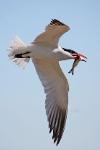 Measuring the Additive Effects of Predation on Prey Survival
Measuring the Additive Effects of Predation on Prey Survival
The degree to which predation is an additive vs. compensatory source of mortality is fundamental to understanding the effects of predation on prey populations and evaluating the efficacy of predator management actions. In the Columbia River basin, USA, predation by Caspian Terns (Hydroprogne caspia) on U.S. Endangered Species Act (ESA)-listed juvenile salmonids (smolts; Oncorhynchus spp.) has led to predator management actions to reduce predation; however, the assumption that reduced predation translates into greater salmonid survival, either within the life stage where predation occurs or across their lifetime, has remained untested. To address this critical uncertainty, we analyzed a long-term (2008–2018) mark–recapture–recovery data set of ESA-listed steelhead trout (O. mykiss) that were tagged (n = 78,409) and subsequently exposed to predation during smolt out-migration through multiple river reaches (spatial scales), jointly estimating weekly probabilities of steelhead survival, mortality due to bird predation, and mortality due to other causes. This concurrent estimation across time-stratified cohorts allowed for the direct measurement of the strength, magnitude, and direction of relationships between survival and Caspian Tern predation. Estimates of Tern predation on steelhead were substantial in most years, with cumulative annual estimates ranging from 0.075 (95% creditable interval = 0.058–0.099) to 0.375 (0.290–0.461). Increases in Tern predation probabilities were associated with statistically significant decreases in steelhead survival probabilities in all evaluated years and salmonid life stages (smolt out-migration and smolt-to-adult returns). Results provide novel evidence that predation by Caspian Terns may have been a super-additive source of mortality during the smolt life stage and a partially additive source of mortality to the adult life stage. Annual estimates of the difference between observed survival and baseline survival (i.e., in the absence of Tern predation) ranged from 0.052 (0.017–0.103) to 0.314 (0.172–0.459) during the steelhead smolt life stage and from 0.011 (0.001–0.029) to 0.049 (0.025–0.078) to the adult life stage. The estimated levels of compensation have important implications for predator management actions aimed at increasing the survival of endangered salmonids, and the modeling approach developed herein provides a framework to directly quantify the impacts of source-specific mortality factors on prey populations.
-Q. Payton, A.F. Evans, N.J. Hostetter, D.D. Roby, B. Cramer, and K. Collis
Click here to see manuscript



